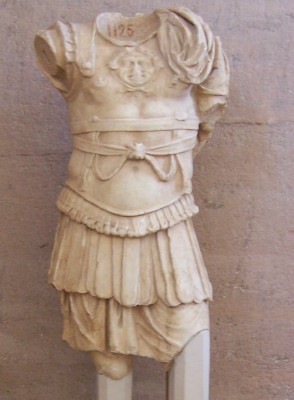|
Military statue and the Body
 This
picture is a sculpture of a man in Roman military garb from the
2nd century AD. Corinth is filled with statues of emperors and
military men. The theater, also designed in the 2nd century by
Romans, has frescos depicting battle scenes. This
picture is a sculpture of a man in Roman military garb from the
2nd century AD. Corinth is filled with statues of emperors and
military men. The theater, also designed in the 2nd century by
Romans, has frescos depicting battle scenes.
How are military statues
significant for understanding the world of Paul?
Men in the military did not come from the bottom of the social
ladder, but closer to the top. Corinthian art indicates that the
society had men of wealth and power. The society was
socially stratified.
 How is Paul remixing his culture?
How is Paul remixing his culture?
This social stratification
created divisions within the Christian church. In order to quell
these divisions, Paul describes the church as a body:
The body is a unit, though it is made up of many parts; and
though all its parts are many, they form one body. So it is with
Christ. For we were all baptized by one Spirit into one
body—whether Jews or Greeks, slave or free—and we were all given
the one Spirit to drink (1 Corinthians, chapter 12:12-13)
In these verses Paul actually says something quite intuitive to
the Greek mind. The idea that collective humans or even the
cosmos functioned liked a body was prevalent in society. That
slaves and free were even in the same body is actually not
particularly striking. At this point, Paul is simply stating
what people thought.
However, Paul quickly starts to remix people's perceptions of
the body. In the Greco-roman mind of Paul's day, hierarchy was
the norm. Those on the bottom served those on top; those on top
took care of those on the bottom by protecting them (militarily)
or providing for them (paying for the construction of temples or
athletic competitions as seen throughout Greece).
Paul completely reject this hierarchical conception of the
church body. He writes:
The eye cannot say to the hand, "I don't need you!" And the
head cannot say to the feet, "I don't need you!" On the
contrary, those parts of the body that seem to be weaker are
indispensable, and the parts that we think are less honorable we
treat with special honor. And the parts that are unpresentable
are treated with special modesty, while our presentable parts
need no special treatment. But God has combined the members of
the body and has given greater honor to the parts that lacked
it, so that there should be no division in the body, but that
its parts should have equal concern for each other. If one part
suffers, every part suffers with it; if one part is honored,
every part rejoices with it. (Chapter 12, verses 21-26)
Paul humbly reminds us that
in Christ, there is neither slave nor free because there is no
more status.
source:
info on
greco-roman understandings of the body: Martin, Dale. The
Corinthian Body. New Haven: Yale University Press, 1995.
|



 This
picture is a sculpture of a man in Roman military garb from the
2nd century AD. Corinth is filled with statues of emperors and
military men. The theater, also designed in the 2nd century by
Romans, has frescos depicting battle scenes.
This
picture is a sculpture of a man in Roman military garb from the
2nd century AD. Corinth is filled with statues of emperors and
military men. The theater, also designed in the 2nd century by
Romans, has frescos depicting battle scenes.